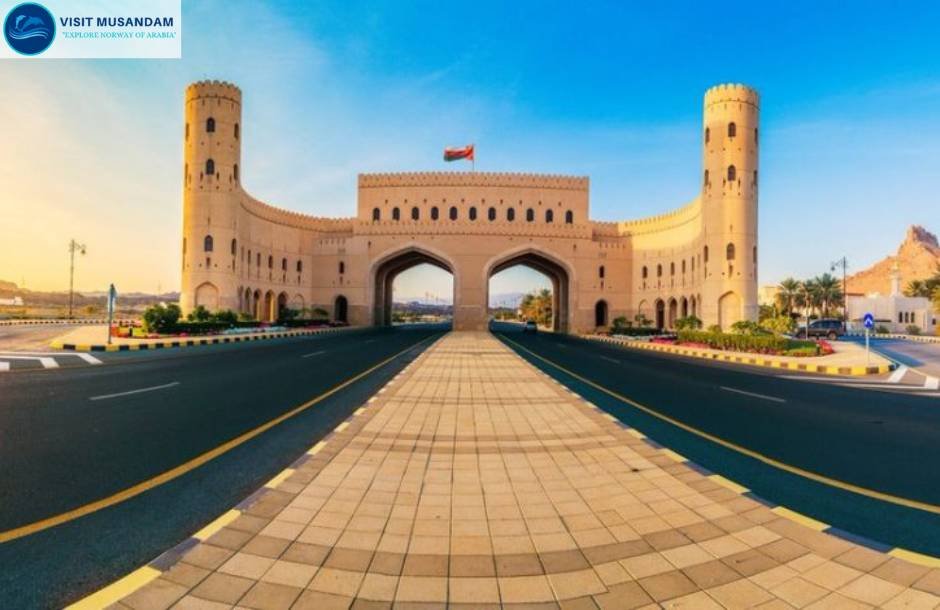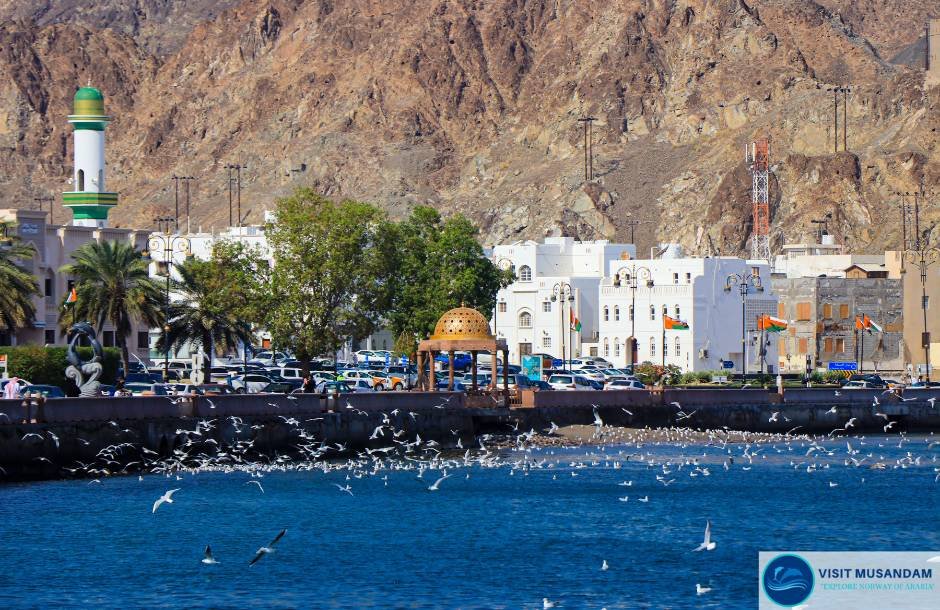
The best time to visit Oman is during the cooler months from October to April. This period offers pleasant weather, ideal for exploring Oman’s breathtaking landscapes and vibrant culture.
During these months, outdoor activities thrive, allowing visitors to experience bustling souks and historic forts fully. If you’re planning to explore Musandam, known for its stunning fjords, this is the perfect time to visit. You can discover more about the Musandam Fjords in Oman for a scenic adventure.
Local festivals often occur during this time, highlighting Oman’s rich traditions and warm hospitality. To enhance your journey, dress in layers to accommodate temperature changes and stay hydrated as you explore the stunning deserts and mountains. Engaging with locals can provide valuable insights, enriching your travel experience. Ready for an adventure? Oman’s enchanting charm awaits!

Ideal Months for Visiting Oman
The ideal months for visiting Oman are from October to April, when the weather is cooler and more comfortable for outdoor activities. During this period, temperatures range from mild to warm, making it perfect for exploring the country’s stunning landscapes and rich culture. For those interested in marine adventures, consider diving in Oman during this period. You can find the best locations for diving in Oman to enhance your underwater experience.
Visiting during these months also allows travelers to experience various festivals and events, enhancing their cultural immersion. Planning your trip around this timeframe guarantees a more enjoyable and memorable experience in Oman.
Research indicates that average daytime temperatures in Muscat during these months range from 25°C to 30°C (77°F to 86°F), making it one of the most favorable climates for tourism in the region.
Why October to April is the Best Time
October to April is the best time to visit Oman due to its mild and pleasant weather.
During these months, temperatures range from 20°C to 30°C (68°F to 86°F), ideal for outdoor activities like hiking and exploring historical sites. If you are interested in family-friendly activities, Oman offers numerous opportunities for both kids and parents. Discover more about family adventures in Oman that cater to all ages.
Additionally, this period coincides with the peak tourism season, offering vibrant festivals and local events.
Weather Conditions During the Best Months
Oman is best visited between October and April. During these months, the weather is cooler, with temperatures ranging from 20°C to 30°C (68°F to 86°F), making it ideal for outdoor activities and exploration. The humidity is lower, particularly in coastal regions, enhancing comfort for travelers.
In contrast, summer months (May to September) can be extremely hot, often exceeding 40°C (104°F), limiting outdoor excursions. As a result, planning a trip during the cooler months guarantees a more enjoyable experience in Oman.
According to a study published by the Oman Meteorological Department, these months consistently show a significant decrease in temperature and humidity levels, reinforcing the recommendation for travel during this period for peak comfort and enjoyment.
Understanding Oman’s Summer Climate
Oman’s summer climate features extreme heat, particularly from June to September, with temperatures often exceeding 40°C (104°F). The high humidity, especially along the coast, can make conditions feel even hotter.
Despite the heat, summer is a great time to explore Oman’s stunning landscapes, such as the Hajar Mountains and desert areas, which can be cooler at higher altitudes. You might want to learn more about the Hajar Mountains in Musandam if you’re planning a visit. Additionally, many coastal resorts offer indoor activities and evening events to escape the daytime heat.
Challenges of Visiting During Summer
Visiting Oman during summer presents significant challenges due to extreme heat. Daytime temperatures can soar above 40°C (104°F), especially in cities like Muscat and Sohar.
The intense humidity, particularly along the coast, can make outdoor activities uncomfortable and exhausting. Travelers should plan for early morning or late afternoon excursions to avoid the peak heat and stay hydrated.
Important note: It is essential for travelers to be aware of the potential health risks associated with extreme temperatures and to prioritize their well-being by taking necessary precautions.
Unique Summer Activities and Events
Oman offers unique summer activities despite its high temperatures. Visitors can engage in evening desert safaris, experience vibrant cultural festivals, and enjoy water sports in coastal areas.
The Khareef season in Salalah transforms the landscape, attracting tourists to lush greenery and cooler climates.
Regional Weather Variations Across Oman
Oman’s weather varies greatly across its regions, influenced by geography and topography. Coastal areas experience milder winters, while the interior regions can become extremely hot during summer.
Understanding these variations is essential for planning the best time to visit, as each region offers unique experiences depending on the season.
Muscat’s Climate Overview
Muscat experiences a hot desert climate characterized by high temperatures and low humidity. The best time to visit is between October and April when daytime temperatures are milder, averaging 25-30°C (77-86°F).
Summers can soar above 40°C (104°F), making outdoor activities uncomfortable. Coastal areas like Salalah offer a more temperate climate, especially during the Khareef season from June to September, attracting visitors seeking cooler weather and lush landscapes.
Jebel Akhdar’s Unique Weather
Jebel Akhdar experiences a unique climate in Oman, characterized by cooler temperatures and higher humidity due to its elevation of around 2,000 meters (6,500 feet).
The best time to visit is from October to April, when temperatures range from 15°C to 25°C (59°F to 77°F), creating ideal conditions for hiking and exploring the region’s stunning landscapes.
The summer months can be scorching, with temperatures soaring above 40°C (104°F), making outdoor activities less enjoyable.
Salalah’s Monsoon Influence
Salalah experiences a unique monsoon season from June to September, known locally as the Khareef. This period transforms the landscape into lush greenery, attracting tourists seeking cooler temperatures and stunning natural beauty. The average temperature drops to around 25°C (77°F), offering a revitalizing escape from Oman’s typically hot climate.
In contrast, other regions in Oman, such as Muscat, remain dry and hot, with temperatures soaring above 40°C (104°F). As a result, the best time to visit Oman, particularly for those interested in experiencing the monsoon’s effects, is during the Khareef season in Salalah.
Musandam Peninsula’s Cooler Climate
The Musandam Peninsula has a cooler climate compared to other regions in Oman, particularly during the summer months. This unique weather is influenced by its geographical position, with mountainous terrain that helps to mitigate the harsh sun and high temperatures found elsewhere. If you’re planning a visit, consider checking out the top camping sites in Musandam for a unique outdoor experience.
The best time to visit is between October and April when temperatures are milder, making it ideal for outdoor activities like hiking and exploring the stunning fjords. Visitors can also enjoy cooler breezes from the sea, enhancing the pleasant atmosphere.
Seasonal Activities and Events in Oman
Oman offers a variety of seasonal activities and events throughout the year, highlighting its rich culture and natural beauty. From vibrant festivals to outdoor adventures, each season brings unique experiences.
Visitors can enjoy traditional events like the Muscat Festival in winter or the Salalah Tourism Festival in summer, making it essential to plan trips accordingly.
Winter Festivals and Events
Oman hosts several winter festivals and events that offer a vibrant cultural experience. The Muscat Festival, held from January to February, showcases Omani heritage through traditional music, dance, and crafts.
Additionally, the Salalah Tourism Festival in Dhofar features stunning landscapes, food stalls, and performances, attracting visitors from across the region.
These events provide a unique opportunity to engage with Omani culture during the cooler months.

Springtime Blooms and Harvests
Spring in Oman, typically from March to May, showcases vibrant flora and agricultural activities. Visitors can enjoy picturesque landscapes adorned with wildflowers, particularly in regions like Jebel Akhdar.
Key events include the Muscat Festival, featuring traditional arts, crafts, and local cuisine, highlighting Oman’s rich cultural heritage while celebrating the season’s bounty.
Summer Turtle Nesting and Khareef
Oman experiences summer turtle nesting from June to September, primarily along its coastline, especially in Ras al Jinz. This event attracts nature enthusiasts and conservationists.
Additionally, the Khareef season, from June to September, transforms Dhofar into a lush green paradise, offering cool temperatures and vibrant landscapes that are perfect for outdoor activities and festivals celebrating the monsoon.
Autumn Harvest and Outdoor Adventures
The best time to visit Oman for autumn harvest and outdoor adventures is from September to November. During this period, the weather is milder, perfect for exploring lush landscapes and experiencing local festivals like the date harvest.
Popular activities include hiking in the Hajar Mountains and visiting vibrant souks in Muscat, making it an ideal season for both cultural immersion and outdoor exploration.
Frequently Asked Questions About Visiting Oman
What is the best month to visit Oman?
The best time to visit Oman is between October and April when temperatures range from 25°C to 30°C, ideal for outdoor activities. During this period, major cultural festivals, like the Muscat Festival in January, showcase Oman’s rich heritage and traditions.
How many days are enough for a trip to Oman?
A trip to Oman typically requires at least 5 days to explore key attractions thoroughly. This duration allows visits to Muscat’s Grand Mosque, Royal Opera House, and Mutrah Souq, along with quick excursions to nearby mountains or deserts. For an extended itinerary, consider traveling from Dubai to Musandam for a diverse experience.
Planning your itinerary around these highlights ensures you maximize your experience within this timeframe.
Is Oman an expensive travel destination?
Oman can be an expensive travel destination, with hotel prices averaging between $100 and $300 per night. Transportation costs also add up, particularly for car rentals or frequent taxi use, as public transport options are limited.
To save money, travelers should consider ride-sharing apps, dining at local markets, and visiting during off-peak seasons.
Is it safe to travel to Oman currently?
Oman is considered safe for tourists as of October 2023, with a low crime rate of 1.3 incidents per 1,000 residents, according to the Global Peace Index. The local population is known for being welcoming and friendly toward visitors.
Can tourists drink alcohol in Oman?
Tourists can legally consume alcohol in Oman, but only in licensed hotels, bars, and restaurants. According to Oman’s Ministry of Tourism, alcohol consumption in public places is strictly prohibited, and visitors should be mindful of local customs and laws.
Is Oman friendly to foreign visitors?
Yes, Oman is very friendly to foreign visitors. According to the Global Peace Index 2021, Oman ranks 70th out of 163 countries, reflecting its low crime rate and welcoming atmosphere for tourists, making it a safe and inviting destination.
Conclusion
When planning your trip to Oman, it’s crucial to consider the best time to visit. Timing your journey allows you to experience the country’s rich culture and stunning landscapes without facing the extreme summer heat. The ideal months for a visit are between October and April when the weather is cooler and numerous vibrant festivals take place.
Understanding these travel details is essential for maximizing your experience. By planning ahead, you can secure accommodations during peak season and engage with local customs, deepening your understanding of Omani heritage. This thoughtful approach will help you create unforgettable memories.
As you prepare for your adventure, remember to embrace the opportunity to immerse yourself fully in Oman’s unique offerings. Take time to explore its diverse attractions and connect with its welcoming people. Are you ready to embark on this remarkable journey?
